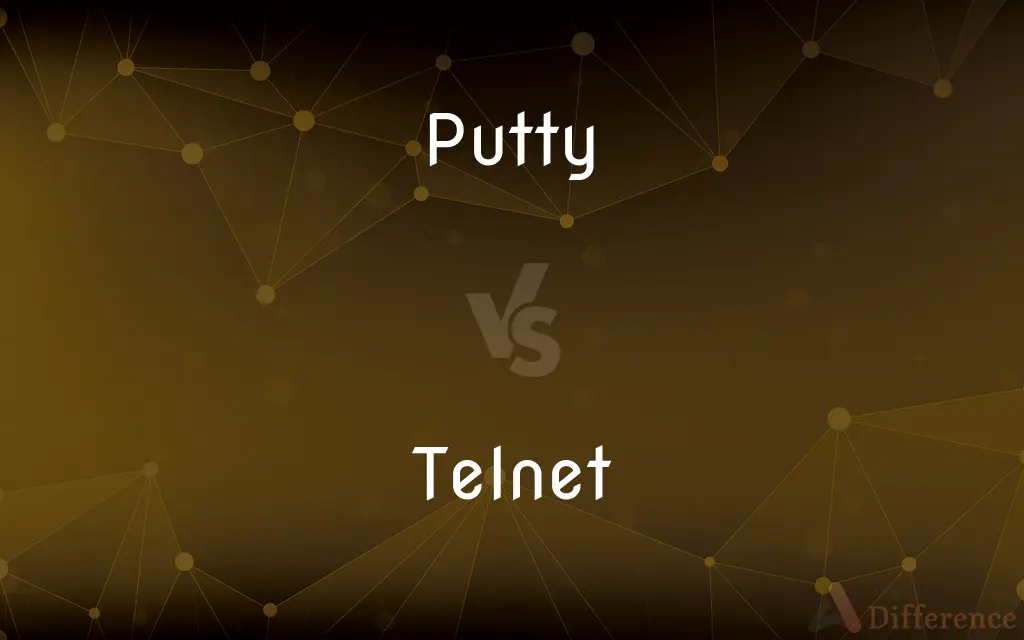PuTTY vs. Telnet — What's the Difference?
By Tayyaba Rehman — Updated on September 21, 2023
PuTTY is a terminal emulator program, while Telnet is a network protocol for remote communication. PuTTY can use Telnet among other protocols.

Difference Between PuTTY and Telnet
Table of Contents
ADVERTISEMENT
Key Differences
PuTTY is a versatile software that acts as a client for various protocols, including SSH, Telnet, rlogin, and SCP. On the other hand, Telnet is specifically a protocol designed to provide bidirectional interactive text communication via a virtual terminal connection.
Many IT professionals turn to PuTTY for its ability to connect to remote systems using a range of protocols. Telnet, being one of those protocols, establishes connections on port 23, facilitating command-line interface access to remote devices.
One of the significant advantages of PuTTY over basic Telnet clients is its support for the SSH protocol. While Telnet transmits data in plain text, potentially exposing sensitive information, SSH offers encrypted communication, ensuring better security.
PuTTY, being a client application, provides a user interface that allows users to configure and initiate connections to remote systems. Telnet, in contrast, doesn't have an interface of its own, as it's a protocol that defines how data should be packaged and transmitted.
In essence, while PuTTY and Telnet might be mentioned together in discussions about remote access, it's crucial to remember that PuTTY is the application through which protocols like Telnet can be utilized, whereas Telnet is the protocol itself.
ADVERTISEMENT
Comparison Chart
Nature
Terminal emulator software/client.
Network protocol.
Protocols Supported
Supports SSH, Telnet, rlogin, SCP, etc.
Is a protocol in itself for text communication.
Security
Supports encrypted protocols like SSH.
Transmits data in plain text.
Usage
Used to initiate and configure connections to remote systems.
Used for remote command-line access.
Implementation
A software application.
A set of rules defining data communication.
Compare with Definitions
Putty
A client software supporting multiple protocols including SSH and Telnet.
PuTTY's versatility allows connections via different protocols.
Telnet
A network protocol for bidirectional text communication.
He used Telnet to access the router's command-line interface.
Putty
A Windows-based application for secure remote access.
He downloaded PuTTY for his Windows laptop to connect to the Linux server.
Telnet
A protocol operating on port 23.
Ensure port 23 is open if you need to access via Telnet.
Putty
A free and open-source terminal emulator.
I used PuTTY to access the remote server securely.
Telnet
A tool for remote access to another computer via a network.
Admins used Telnet to troubleshoot network devices in the past.
Putty
A popular tool for remote server administration.
System administrators often rely on PuTTY for managing remote devices.
Telnet
A text communication system without native encryption.
Due to its lack of encryption, Telnet isn't recommended for sensitive tasks.
Putty
A software offering a graphical interface for network connections.
Using PuTTY's interface, she configured the connection settings easily.
Telnet
A method for command-line interface access on remote devices.
With Telnet, technicians can execute commands remotely.
Putty
Putty is a material with high plasticity, similar in texture to clay or dough, typically used in domestic construction and repair as a sealant or filler. Although some types of putty (typically those using linseed oil) slowly polymerise and become stiff, many putties can be reworked indefinitely, in contrast to other types of filler which typically set solid relatively rapidly.
Telnet
Telnet is an application protocol used on the Internet or local area network to provide a bidirectional interactive text-oriented communication facility using a virtual terminal connection. User data is interspersed in-band with Telnet control information in an 8-bit byte oriented data connection over the Transmission Control Protocol (TCP).
Putty
A doughlike cement made by mixing whiting and linseed oil, used to fill holes in woodwork and secure panes of glass.
Telnet
Also Telnet An internet communications protocol that enables a computer to function as a terminal working from a remote computer.
Putty
A substance with a similar consistency or function.
Telnet
A program that implements this protocol.
Putty
A fine lime cement used as a finishing coat on plaster.
Telnet
To access an account over the internet using the telnet protocol
Telnetted from her work computer to her university account.
Putty
A yellowish or light brownish gray to grayish yellow or light grayish brown.
Telnet
(computing) A network protocol that enables one computer to communicate with another via the Internet; the program that acts as the client in this situation
Putty
To fill, cover, or secure with putty.
Telnet
To use such a program to make such a connection
Putty
A form of cement, made from linseed oil and whiting, used to fix panes of glass.
Putty
Any of a range of similar substances.
Putty
An oxide of tin, or of lead and tin, used in polishing glass, etc.
Putty
A fine cement of lime only, used by plasterers.
Putty
A golf ball made of composition and not gutta-percha.
Putty
Of, pertaining to, or resembling putty.
Putty
(transitive) To fix or fill using putty.
Putty
A kind of thick paste or cement compounded of whiting, or soft carbonate of lime, and linseed oil, when applied beaten or kneaded to the consistence of dough, - used in fastening glass in sashes, stopping crevices, and for similar purposes.
Putty
A ball made of composition and not gutta percha.
Putty
A kind of gaiter of waterproof cloth wrapped around the leg, used by soldiers, etc.
Putty
To cement, or stop, with putty.
Putty
A dough-like mixture of whiting and boiled linseed oil; used especially to patch woodwork or secure panes of glass
Putty
Apply putty in order to fix or fill;
Putty the window sash
Common Curiosities
What is PuTTY used for?
PuTTY is used for remote access to servers and devices using various protocols, including SSH and Telnet.
Is Telnet secure?
No, Telnet transmits data in plain text, making it insecure for sensitive communications.
Why is SSH preferred over Telnet?
SSH is encrypted, ensuring data confidentiality, while Telnet is not.
Is PuTTY available for platforms other than Windows?
While originally for Windows, variations and ports like PuTTY for Linux exist.
How do I connect using Telnet via PuTTY?
In PuTTY, select 'Telnet' as the connection type and enter the remote host's details.
Are there alternatives to PuTTY?
Yes, alternatives include MobaXterm, SecureCRT, and OpenSSH clients.
Can PuTTY use protocols other than Telnet?
Yes, PuTTY supports multiple protocols including SSH, rlogin, and SCP.
Why might one use Telnet today?
Telnet might be used in closed, trusted environments, or for legacy system access.
Does PuTTY save session configurations?
Yes, PuTTY allows users to save session details for quicker future connections.
Is it safe to use Telnet over public networks?
No, due to its plain-text nature, Telnet is vulnerable to eavesdropping over public networks.
Share Your Discovery

Previous Comparison
Indemnity vs. Guarantee
Next Comparison
Xylophone vs. MarimbaAuthor Spotlight
Written by
Tayyaba RehmanTayyaba Rehman is a distinguished writer, currently serving as a primary contributor to askdifference.com. As a researcher in semantics and etymology, Tayyaba's passion for the complexity of languages and their distinctions has found a perfect home on the platform. Tayyaba delves into the intricacies of language, distinguishing between commonly confused words and phrases, thereby providing clarity for readers worldwide.
















































